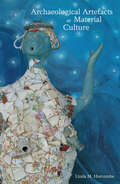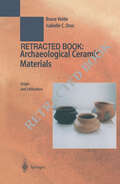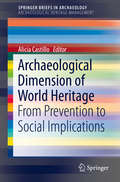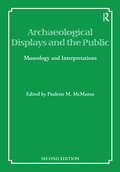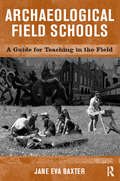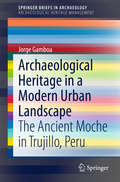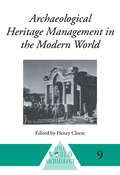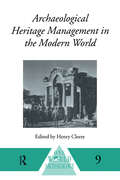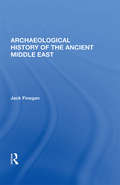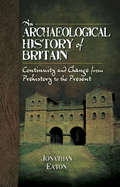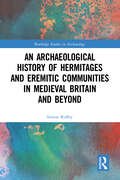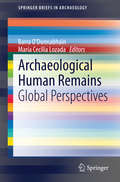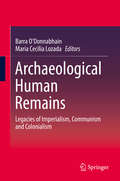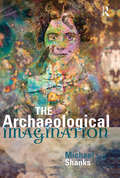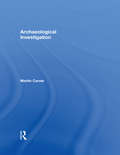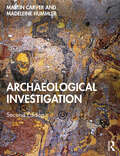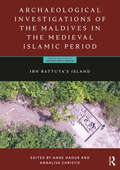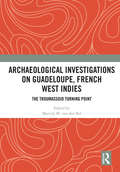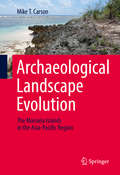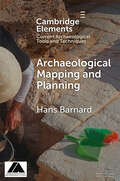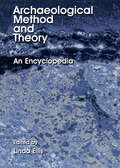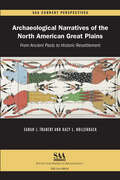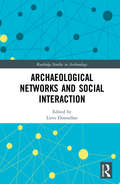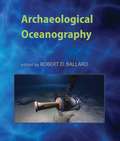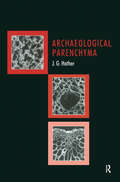- Table View
- List View
Archaeological Artefacts as Material Culture
by Linda HurcombeThis book is an introduction to the study of artefacts, setting them in a social context rather than using a purely scientific approach. Drawing on a range of different cultures and extensively illustrated, Archaeological Artefacts and Material Culture covers everything from recovery strategies and recording procedures to interpretation through typology, ethnography and experiment, and every type of material including wood, fibers, bones, hides and adhesives, stone, clay, and metals. With over seventy illustrations with almost fifty in full colour, this book not only provides the tools an archaeologist will need to interpret past societies from their artefacts, but also a keen appreciation of the beauty and tactility involved in working with these fascinating objects. This is a book no archaeologist should be without, but it will also appeal to anybody interested in the interaction between people and objects.
Archaeological Ceramic Materials: Origin and Utilization (Natural Science in Archaeology)
by Bruce Velde Isabelle C. DrucArchaeological Ceramic Materials is an introduction to the origin and the analysis of the most abundant material found in archaeologyceramics. In this volume, the authors explain the origin of the components of ceramic materials, the choice of these materials by potters as a function of use and physical properties, the effects of firing on ceramic materials, and the means used to analyze the ceramics in a post-use context.
Archaeological Dimension of World Heritage: From Prevention to Social Implications (SpringerBriefs in Archaeology)
by Alicia CastilloThis volume presents case studies from around the world aiming to serve as a hands-on book for management and treatment of archaeological World Heritage properties. It comprises not only sites inscribed as World Heritage due to their archaeological character but also World Heritage properties where the analysis of their archaeological dimension provides a deeper and better understanding of the assets and includes the potential for disseminating this knowledge. The book has an important practical value, since all the works presented here illustrate - with practical examples, the best and most appropriate ways to manage World Heritage properties. The aim of the heritage managers at these World Heritage sites is to improve conservation and increase understanding and communication in such a way that the communities living in those sites or who earn a livelihood from them can be positively affected by these initiatives. The book presents exemplary models of heritage management in World Heritage properties-an issue not treated in depth up to now and Best Practices in this management. Therefore, this volume becomes a new, original source presenting model strategies to be followed by other initiatives in order to improve the consideration and treatment of the most outstanding valued sites considered by UNESCO.
Archaeological Displays and the Public: Museology and Interpretation, Second Edition (UCL Institute of Archaeology Publications)
by Paulette M. McManusThis volume is a set of a dozen case studies of innovative programs designed to attract the public to both archaeological sites and exhibits of archaeological artifacts. Papers deal with general issues of interpretation and presentation and cover British, Australian, European, and American settings.
Archaeological Field Schools: A Guide for Teaching in the Field
by Jane Eva BaxterThe field school is often described as a “rite of passage” among archaeologists. They are considered essential for the appropriate training of students for academic or professional archaeological careers, and are perhaps the only universal experience in an increasingly diverse array of archaeological career paths. Jane Baxter’s practical guide about how to run a successful field school offers archaeologists ways to maximize the educational and training benefits of these experiences. She presents a wide range of pedagogical theories and techniques that can be used to place field schools in an educational, as well as an archaeological, context. Baxter then offers a “how to” guide for the design of field schools, including logistical, legal, and personnel issues as well as strategies for integrating research and teaching in the field. Replete with checklists, forms, and cogent examples, the author gives directors and staff a set of “best practices” for designing and implementing a school.
Archaeological Heritage in a Modern Urban Landscape: The Ancient Moche in Trujillo, Peru (SpringerBriefs in Archaeology #13)
by Jorge GamboaArchaeological Heritage in a Modern Urban Landscape evaluates issues about the preservation, social role and management of archaeological sites in the Trujillo area, north coast of Peru, specifically those of the Moche culture (100-800 AD). Moche was one of the great civilizations of ancient Peru, with spectacular ceremonial adobe architecture and settlements distributed across a landscape formed by coastal valleys and one of the largest deserts of South America. In the last decades political and economic changes have brought rural migrations to the city of Trujillo and nearby zones, causing the emergence of extensive new communities in the margins of the metropolis. And although Trujillo's Moche heritage has become a symbol of regional identity, most local Moche sites are under siege because of urban development. This book offers a new perspective on the development of modern communities settled beside archaeological sites and contributes to improving best practices in the management of archaeological sites and preservation in an urban setting.
Archaeological Heritage Management (One World Archaeology Ser.)
by Henry CleereThis book results from discussions at the 1982 World Archaeological Congress on 'Public Archaeology and Cultural Resource Management'. It brings to everyone's notice the common need of a coherent, well-planned response to the potentially destructive threats of development and tourism to archaeology.
Archaeological Heritage Management in the Modern World (One World Archaeology)
by Henry CleereRepresenting the latest thinking in this fast-moving and often emotive field, this book offers a remarkably comprehensive international coverage of the public aspects of archaeology. The process of survey and inventory, rescue and archaeology, conservation and protection have until now been studied largely on the basis of individual countries and their administrative and legislative structures. Now, by virtue of its broad geographical coverage, this volume provides many rights and guidelines not hitherto brought into focus: the history and philosophy of archaeological heritage management, case studies (regional, national and specialised), and the training and qualification of archaeologists for heritage management.This book is essential reading for all students, researchers and practitioners concerned with archaeological heritage management, public administration and the legal community whose work involves archaeological issues.
Archaeological History Of The Ancient Middle East
by Jack FineganThe purpose of this book is to give a connected account of what happened in the ancient Middle East, primarily on the basis of the records and monuments that have been recovered through the work of modem archaeology. The Middle East is defined as extending from the western border of Egypt (20 degrees E) to the eastern border of Iran (60 degrees E),
An Archaeological History of Britain: Continuity and Change from Prehistory to the Present
by Jonathan EatonThis authoritative and accessible volume presents an archeological of Britain across millennia, from early prehistory to the present. The Archaeological History of Britain takes us from the earliest prehistoric archaeology right up to the contemporary archaeology of the present day through the use of key sites. Historian Jonathan Eaton uses key sites to illustrate each significant time period along with a narrative of change to accompany the changing archaeological record. The wide range of evidence utilized by archaeologists, such as artefacts, landscape studies, historical sources and genetics are emphasized throughout this chronological journey. The latest theoretical advances and practical discoveries are also explored, making this the most advanced narrative of British archaeology available.
An Archaeological History of Hermitages and Eremitic Communities in Medieval Britain and Beyond (Routledge Studies in Archaeology)
by Simon RoffeyMany hermitages and eremitic communities are recorded throughout the medieval period, yet to date, there has been no comprehensive archaeological study. This richly illustrated book will consequently discuss a range of hermitages and introduce the reader to their architectural forms, spaces, location and environments as well as the religious practices associated with them. It will focus primarily on the British material but will nonetheless consider this within a wider comparative framework. Overall, it will offer an archaeological history of hermitages and presents a unique window into a lost world of medieval spirituality and religious life. Key related themes will include the earliest archaeological evidence for hermits (eremitic life) in India, China and East Asia, pre- and early Christian desert hermitages, cave hermitages, eremitic communities, saints and missionary hermits, life and diet, medieval mysticism and the contemplative tradition, secular and ornamental hermitages and hermits in post-medieval and contemporary society. This book offers an illustrated archaeological history of hermitages and eremitic communities, with reference to key examples and case studies. It will therefore appeal to both academics, students and a more general readership interested in archaeology, history, comparative religion, architecture, religion and belief, spirituality, medieval Britain, modern contemplative practice and contemporary heritage issues.
Archaeological Human Remains: Global Perspectives (SpringerBriefs in Archaeology)
by Barra O'Donnabhain María Cecilia LozadaThis volume addresses the directions that studies of archaeological human remains have taken in a number of different countries, where attitudes range from widespread support to prohibition. Overlooked in many previous publications, this diversity in attitudes is examined through a variety of lenses, including academic origins, national identities, supporting institutions, archaeological context and globalization. The volume situates this diversity of attitudes by examining past and current tendencies in studies of archaeologically-retrieved human remains across a range of geopolitical settings. In a context where methodological approaches have been increasingly standardized in recent decades, the volume poses the question if this standardization has led to a convergence in approaches to archaeological human remains or if significant differences remain between practitioners in different countries. The volume also explores the future trajectories of the study of skeletal remains in the different jurisdictions under scrutiny.
Archaeological Human Remains: Legacies of Imperialism, Communism and Colonialism (Springerbriefs In Archaeology Ser.)
by Barra O'Donnabhain Maria Cecilia LozadaThis book expands on Archaeological Human Remains: Global Perspectives that was published in the Springer Briefs series in 2014 and which had a strong focus on post-colonial countries. In the current volume, the editors include papers that deal with non-Anglophone European traditions such as Portugal, Germany and France. In addition, authors continue the exploration of osteological trajectories that are not well-documented in the West, such as Senegal, China and Russia. The lasting legacies of imperialism, communism and colonialism are apparent as the authors of the individual country profiles examine the historical roots of the study of archaeological human remains and the challenges encountered while also considering the likely future directions likely of this multi-faceted discipline in different world areas.
The Archaeological Imagination
by Michael ShanksArchaeology is a way of acting and thinking—about what is left of the past, about the temporality of what remains, about material and temporal processes to which people and their goods are subject, about the processes of order and entropy, of making, consuming and discarding at the heart of human experience. These elements, and the practices that archaeologists follow to uncover them, is the essence of the archaeological imagination. In this extended essay, renowned archaeological theorist Michael Shanks offers his colleagues and students a window on this imaginative world of past and present and the creative role archaeology can play in uncovering it, analyzing it, and interpreting it.
Archaeological Investigation
by Martin CarverDrawing its numerous examples from Britain and beyond, Archaeological Investigation explores the procedures used in field archaeology travelling over the whole process from discovery to publication. Divided into four parts, it argues for a set of principles in part one, describes work in the field in part two and how to write up in part three. Part four describes the modern world in which all types of archaeologist operate, academic and professional. The central chapter ‘Projects Galore’ takes the reader on a whirlwind tour through different kinds of investigation including in caves, gravel quarries, towns, historic buildings and underwater. Archaeological Investigation intends to be a companion for a newcomer to professional archaeology – from a student introduction (part one), to first practical work (part two) to the first responsibilities for producing reports (part three) and, in part four, to the tasks of project design and heritage curation that provide the meat and drink of the fully fledged professional. The book also proposes new ways of doing things, tried out over the author’s thirty years in the field and brought together here for the first time. This is no plodding manual but an inspiring, provocative, informative and entertaining book, urging that archaeological investigation is one of the most important things society does.
Archaeological Investigation
by Martin Carver Madeleine HummlerThe thoroughly updated second edition of Archaeological Investigation reviews and explains the practices of field archaeology in the world today. Now co-authored by Madeleine Hummler, the book’s scope has been enlarged in time and space, reaching out to the different methods and strategies applied in both the academic and commercial sectors in diverse terrain on land and under the sea.Archaeological Investigation accompanies the reader on a journey from absolute beginner to professional. Part 1 (Principles) sets the scene for newcomers, showing the axial role of fieldwork in rediscovering the past. Part 2 (In the Field) is aimed at those setting out to collect primary data by the diverse methods of modern survey and excavation. Word pictures on "First day in the field" and "First day on a dig" provide friendly introductions to the high-tech enterprise that fieldwork has become. Now fully engaged in the process, newcomers to archaeology are ready, in Part 3 (Writing Up), to take part in the process of making the discoveries known. Here the findings of fieldwork are marshalled to analyse the assemblage, the use of space and the chronology of what happened. The results are then combined in a synthesis and communicated through websites, museums, the display of sites and above all through publication. Part 4 (Design) engages the reader in archaeology’s primary action: how to design projects that conserve, rediscover and explain the human past, beginning with a review of some landmark examples (Chapter 13). The final chapter (The Profession) reviews the role of the state, the academy, the commercial sector and the public in making archaeology happen – and why it matters.Building on the authors’ extensive experience, Archaeological Investigation remains an inspiring, provocative, informative and entertaining book for students and professionals, arguing that the investigation of the human and environmental past is highly relevant to contemporary society and its future.
Archaeological Investigations of the Maldives in the Medieval Islamic Period: Ibn Battuta’s Island (British Institute in Eastern Africa Memoir)
by Anne Haour Annalisa ChristieThis book presents pioneering research on the Indian Ocean archipelago of the Maldives in the medieval period. Primarily archaeological, the book has an interdisciplinary slant, examining the material culture, history, and environment of the islands. Featuring contributions by leading archaeologists and material culture researchers, the book is the first systematic archaeological monograph devoted to the Maldives. Offering an archaeological account of this island-nation from the beginnings of the Islamic period, it complements and nuances the picture presented by external historical data, which identify the Maldives as a key player in global networks. The book describes excavations and surveys at a medieval site on the island of Kinolhas. It offers a comprehensive analysis of finds of pottery, glass, and cowries, relating them to regional assemblages to add valuable new data to an under-researched field. The artefacts suggest links with India, Sri Lanka, the Middle East, Arabia, central Asia, southeast Asia, and China, offering tangible evidence of wider connections. The research also evidences diet, crafts, and funerary practices. The rigorous presentation of the primary material is framed by chapters setting the context, conceptual approaches, and historical interpretation, placing the Maldives within broader dynamics of Islamic and Indian Ocean history and opening the research results to a wide readership. The book is aimed at students and researchers interested in the archaeology and history of the Indian Ocean, Islamic studies, island and coastal communities, maritime networks, and the medieval period, with special relevance for the ‘Global Middle Ages’. It will appeal to art historians, archaeologists, museologists, and heritage and material culture studies researchers with related interests.
Archaeological Investigations on Guadeloupe, French West Indies: The Troumassoid Turning Point
by Martijn M. van den BelComprising 20 scientific contributions to the archaeology of Guadeloupe, French West Indies (FWI), this volume places the latter Caribbean Island in the spotlight by presenting the results of four contemporaneous archaeological sites. By means of these four sites, this book explores a variety of issues contemplating the transition from the Early to the Late Ceramic Age in the Lesser Antilles. Studies of pre-Columbian material culture (ceramics, lithics, faunal, shell and human bone remains) are combined with additional microanalyses (starch and phytolith analyses, micromorphology and thin sections) to sort out the processes that triggered the cultural transition just before the end of the first millennium AD. The multi-disciplinary approach to address these sites Saladoid shows the current state of affairs on project-led archaeology in the French West Indies and should be of great value to both researchers and students of Caribbean archaeology, material cultures, zooarchaeology, environmental studies, historical ecology and other related fields.
Archaeological Landscape Evolution: The Mariana Islands in the Asia-Pacific Region
by Mike T. CarsonLandscapes have been fundamentalto the human experience world-wide and throughout time, yet how did we as humanbeings evolve or co-evolve with our landscapes? By answering this question, we can understand our place in the complex,ever-changing world that we inhabit. Thisbook guides readers on a journey through the concurrent processes of change inan integrated natural-cultural history of a landscape. While outlining the general principles forglobal application, a richly illustrated case is offered through the MarianaIslands in the northwest tropical Pacific and furthermore situated in a largerAsia-Pacific context for a full comprehension of landscape evolution atvariable scales. The author examines whathappened during the first time when human beings encountered the world's RemoteOceanic environment in the Mariana Islands about 3500 years ago, followed by acontinuous sequence of changing sea level, climate, water resources, forestcomposition, human population growth, and social dynamics. This book provides a high-resolution andlong-term view of the complexities of landscape evolution that affect all of ustoday.
Archaeological Mapping and Planning (Elements in Current Archaeological Tools and Techniques)
by Hans BarnardThis richly illustrated Element introduces the reader to the basic principles of archaeological mapping and planning. It presents both the mathematical and the practical backgrounds, as well as many tips and tricks. This will enable archaeologists to create acceptable maps and plans of archaeological remains, even with limited means of in adverse circumstances.
Archaeological Method and Theory: An Encyclopedia
by Linda EllisThis Encyclopedia brings together the most recent scientific information on a collection of subjects that are too often - and inconveniently - treated in separate publications. It provides a survey of archaeological method and theory, as well as the application of physical and biological sciences in archaeological research. Every aspect of archaeological work is represented, from the discovery process to the ultimate disposition of materials. Thus the reader will find entries on subject matter covering: * disciplinary theory * legislation affecting the work of archaeologists * pre-excavation surveying * excavation methodology * on-site conservation techniques * post-excavation analysis The rapid evolution of analytical technology is often superficially treated or not covered at all in textbooks or other commonly available sources. Here, the latest refinements in techniques such as radiometric dating, stable isotopic analysis, and the PCR technique of DNA analysis are presented clearly and authoritatively. The discussion of these techniques is amplified by including results of the work of professionals conducting interdisciplinary research and by covering the methodologi enhancements provided by the physical and natural sciences. Cultural property legislation, regardless of its country of origin, has affected how archaeologists conduct their work. This encyclopedia covers all major U.S. legislation developed for the protection of cultural property, including the recent Native American Graves Protection and Repatriation Act, and offers a substantial article on worldwide legislation concerning the reburial of human remains and its effects on the present and future practice of archaeology. Without some sort of conservation program at the point of excavation, valuable materials may be inadvertently contaminated or destroyed. Many simple and low-cost techniques to promote both sample integrity and long-term preservation for major classes of materials are described in this volume. Traditional treatments of method and theory usually focus on prehistoric periods and are limited in their geographic range. This volume includes discussions based on various historical periods on different continents, as reflected in entries such as Historical Archaeology, Industrial Archaeology, Medieval Archaeology, and Classical Archaeology.
Archaeological Narratives of the North American Great Plains: From Ancient Pasts to Historic Resettlement (SAA Current Perspectives)
by Sarah J. Trabert Kacy L. HollenbackStretching from Canada to Texas and the foothills of the Rockies to the Mississippi River, the North American Great Plains have a complex and ancient history. The region has been home to Native peoples for at least 16,000 years. This volume is a synthesis of what is known about the Great Plains from an archaeological perspective, but it also highlights Indigenous knowledge, viewpoints, and concerns for a more holistic understanding of both ancient and more recent pasts. Written for readers unfamiliar with archaeology in the region, the book in the SAA Press Current Perspectives Series emphasizes connections between past peoples and contemporary Indigenous nations, highlighting not only the history of the area but also new theoretical understandings that move beyond culture history. This overview illustrates the importance of the Plains in studies of exchange, migration, conflict, and sacred landscapes, as well as contact and colonialism in North America. In addition, the volume includes considerations of federal policies and legislation, as well as Indigenous social movements and protests over the last hundred years so that archaeologists can better situate Indigenous heritage, contemporary Indigenous concerns, and lasting legacies of colonialism today.
Archaeological Networks and Social Interaction (Routledge Studies in Archaeology)
by Lieve DonnellanArchaeological Networks and Social Interaction focuses on conceptualisations of human interaction, human-thing entanglement, material affordances and agency. Network concepts in the archaeological discipline are ubiquitous these days. They range from loose concepts, used as metaphors to address a notion of connectivity, to highly formal and mathematically complex predictions of human behaviour. These different networked worlds sometimes clash and rarely converge. Archaeologists interested in network analysis, however, have achieved a much better understanding of the implications of adopting formal methods for studying social interaction and there have been theoretical advancements realising a better synergy between different theoretical perspectives. These nascent concerns are explored further in this volume with regional specialists exploring case studies from Prehistory to the Middle Ages throughout the Ancient and New Worlds, outlining how formal network approaches contribute to studying social interaction archaeologically. This book will be of interest to archaeologists wishing to access the latest research on networks and interconnectivity and how these approaches have been productively modified to archaeological research.
Archaeological Oceanography
by Robert D. BallardArchaeological Oceanography is the definitive book on the newly emerging field of deep-sea archaeology. Marine archaeologists have been finding and excavating underwater shipwrecks since at least the early 1950s, but until recently their explorations have been restricted to depths considered shallow by oceanographic standards. This book describes the latest advances that enable researchers to probe the secrets of the deep ocean, and the vital contributions these advances offer to archaeology and fields like maritime history and anthropology. Renowned oceanographer Robert Ballard--who stunned the world with his discovery of the Titanic deep in the North Atlantic--has gathered together the pioneers of archaeological oceanography, a cross-disciplinary group of archaeologists, oceanographers, ocean engineers, and anthropologists who have undertaken ambitious expeditions into the deep sea. In this book, they discuss the history of archaeological oceanography and the evolution and use of advanced deep-submergence technology to locate and excavate ancient and modern shipwrecks and cultural and other sites deep under water. They offer examples from their own expeditions and explain the challenges future programs face in obtaining access to the resources needed to carry out this important and exciting research. The contributors are Robert D. Ballard, Ali Can, Dwight F. Coleman, Mike J. Durbin, Ryan Eustace, Brendan Foley, Cathy Giangrande, Todd S. Gregory, Rachel L. Horlings, Jonathan Howland, Kevin McBride, James B. Newman, Dennis Piechota, Oscar Pizarro, Christopher Roman, Hanumant Singh, Cheryl Ward, and Sarah Webster.
Archaeological Parenchyma (UCL Institute of Archaeology Publications)
by Jon G HatherThe parenchymous remains of roots and tubers are increasingly becoming recognized as an important category of plant remain alongside seeds, fruits and wood charcoal. Identification is however frequently viewed as problematical and such important indicators of past diet are often left unidentified. This book describes the full range of anatomical and morphological characters used in the identification of the parenchymous remains of roots and tubers. Each of the characters is illustrated by photographs of modern and archaeological plant tissues and by line drawings. Further sections of the book also deal with the examination of archaeological tissues and the preparation of modern plant tissue reference collections.
